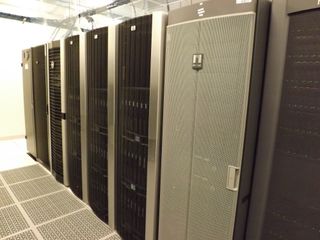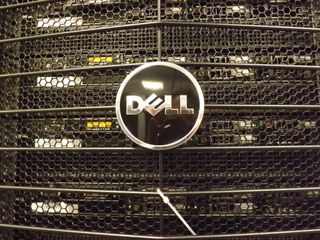We Take a Tour of AMD's Datacenter in Georgia
We take a stroll through AMD's new datacenter located in Suwanee, Georgia.

We recently paid a visit to AMD's new datacenter in Suwanee, Georgia. Located just north of Atlanta, the company chose this spot thanks to less expensive power and tax advantages provided by the state. We were accompanied by Corporate Vice President and CIO Jake Dominguez, Corporate Vice President of Global Infrastructures & Operations Andy Bynum, and Director of Server Software Planning Margaret Lewis.
This datacenter is the byproduct of AMD's mission to reduce costs, increase productivity and increase efficiency. The company introduced its Data Center Consolidation (DCC) plan back in November 2012, which includes moving AMD's datacenter from Austin, Texas to the Suwanee location. By doing this, AMD was able to sell the Austin campus and lease the Georgia-based building for a number of years. This arm of the consolidation plan concluded in September 2013, providing $8.5 million in annual savings.
The ultimate goal, AMD states, is to consolidate its 18 datacenter facilities spread out across the globe, and have only two datacenters worldwide by 2015: Suwanee, Georgia and Cyberjaya, Malaysia. The company has already virtualized 90 percent of the corporate datacenter environment, allowing AMD to decommission 75 percent of its physical servers and 72 percent of its virtual servers.
That said, rack space was compressed by 45 percent and the Engineering GRID Storage reduced by 35 percent. More specifically, the company compressed from 289 racks in Austin to 160 racks in Suwanee, bringing the power consumption down from 2.8 MWs to 1.2 MWs. Thanks to this consolidation, projects that took weeks to complete can now be done in just a matter of days.

Jake Dominguez said that refreshing its technology is one of the key threads the company is working on. "As like any other company, over time our assets have been aging. Andy joined us last year and he's really focused on revamping the infrastructure and we've got this concept now within AMD where every year at a minimum we're going to refresh a certain percentage of the technology and hopefully in a rhythm where every four or five years we refresh and recycle."
The new datacenter features a modern Tier III design and equipment, redundant power, cooling and networking. The Suwanee center also has 36 to 48 hours of backup fuel capacity for diesel generators and on-premises chilled water storage. Firewall rules installed between business-related transaction zones help reduce virus infection and the unexpected loss of IP.
"A Tier-3 datacenter has both redundant components (n + 1) and multiple independent power and cooling distribution paths serving data processing equipment," an AMD rep said in an email. "However only one path is active at a time. As such, routine maintenance and some unplanned outages will have no negative impact on data processing equipment. Tier-3 datacenters usually provide something close to 99.98 percent availability."
Stay on the Cutting Edge
Join the experts who read Tom's Hardware for the inside track on enthusiast PC tech news — and have for over 25 years. We'll send breaking news and in-depth reviews of CPUs, GPUs, AI, maker hardware and more straight to your inbox.
Right now the datacenter includes two data halls totaling approximately 6,000 square feet of IT space, which supports 204 racks of IT equipment. IT power is 2 MW, but expandable to 10 MW through "modular construction methodology." This datacenter also processes 23 million jobs per month; more than 31,000 jobs are completed per hour.
AMD's datacenter uses hot isle containment to improve the efficiency of the cooling equipment. The company is also using a higher chilled water temperature, which requires less infrastructure in the chilled water plant and, according to the company, higher input temperature than a typical enterprise datacenter.

AMD performed an IT refresh before moving facilities, thus reducing the power requirement and the needed space by up to 50 percent annually. As an example, AMD replaced four racks of four-year-old equipment with one rack of modern equipment. The company also sees performance improvement and significant cost savings by using Apache Hadoop, Apache HBase using the Apache HDFS distributed file system, and by using WebFS, Hive and Zookeeper on Opteron-powered Dell servers.
The IT refresh in Austin included replacing single and dual-core single processor systems with more than 140 2x16 core and 4x16 core server blades with 256 GB of memory. The CPUs used in Suwanee include the AMD Opteron 6136, 6174, 6176, 6204, 6220, 6238, 6272, 6274, 6276, 6282 SE, and the Opteron 2435, 6380, and 8389.
With the company narrowing its datacenter real estate down to only two locations, what kind of disaster recovery plan will the company have in place?
"We're trying to put in a recovery environment, and that will be in our Cyberjaya, Malaysia datacenter," Dominguez said. "What we've done is instead of recreating the entire environment within AMD, what we want to do is put the minimum type of capability and functionality to keep this organization operational. So we're going to be able to take orders, load the factories, ship product and invoice. If we can do those four fundamental processes, we can keep the lights on, we can keep the organization running if we had a major disaster."
He later said that up to two years ago, AMD was spending about 30 percent of its resources on innovation and 70 percent on maintenance activity. The company is working to flip that, looking to achieve 80 percent on innovation and 20 percent on maintenance. Right now AMD is spending 60 percent on innovation and 40 percent on maintenance activity.
UPDATE - AMD has this to share regarding SeaMicro: "Our grid is now comprised of 10% of the SeaMicro 15000 systems and is increasing as we refresh older systems. We have seen a 10-20 percent increase in performance on some of our EDA tools thus saving us DC power and cooling at the same time."
Stay tuned for our upcoming gallery from AMD's Datacenter
-
Master467 Why does AMD need all this power to sell chips? Are they for designing chips or just LOTS of inventory management?Reply -
ethanolson Wow... a Dell rack, a NetApp rack and a ton of HP blades. I think I know who's leading the consolidation effort. Hint: it's the blades.Reply -
Jaroslav Jandek Reply
Yes, they are mostly for the transistor and logic simulations in electronic design automation. It takes a lot of power to simulate all those billions of transistors and logic gates in a timely fashion.13028571 said:Are they for designing chips or just LOTS of inventory management? -
BoredSysAdmin Georgia, Really? I wonder if AMD had compared cost vs building the DC somewhere in Great lakes region (big hit - Much, Much cooler weather) vs short term tax breaks in GA??Reply -
skit75 I'm usually mugged for my camera equipment when I enter a datacenter. I won't ask you where you hid your camera but, those pictures have a odor about them. =DReply -
Mysteoa ReplyI'm usually mugged for my camera equipment when I enter a datacenter. I won't ask you where you hid your camera but, those pictures have a odor about them. =D
You can see the camera on the last picture in Dell"s logo -
Tejkion @EthanNolson: Why wouldn't AMD use HP blades? HP/Compaq have been using AMD chips in their PCs since at the 486 days, if not sooner. Why would you go with a vendor like Dell, who, at best, sparsely uses your chips, and for the most part only as a threat to intel to keep intel's prices lower when it comes time to buy more chips. And by it's very nature, NetApp is not going to use a lot of AMD chips...at least not at the moment, when compared to what the other, more PC centric vendors would use.Reply -
Nickmasino (Georgia, Really? I wonder if AMD had compared cost vs building the DC somewhere in Great lakes region (big hit - Much, Much cooler weather) vs short term tax breaks in GA??). Metro Atlanta is a Mission Critical HUB in the Americas. AMD's DC is across the street from a QTS DC & their HQ and 1 of HP's 6 N. American DCs. Suwanee, Gwinnett County has the largest concentration of GA Tech Alumni and 2 times the Tech Workforce of the average US County. This location along Data Center Alley has reliable and competitive power from GA Power & Jackson EMC. If you want to know more contact Nick Masino, SVP Gwinnett Economic Development nick@gwinnettchamber.org or 404.667.6425Reply -
vabello With 70% of their budget going to maintenance, why in the hell are their Dell PowerEdge R415's in the picture all showing hardware related issues needing to be addressed???Reply -
vabello Sorry, R815's... I didn't zoom in on the picture... but still, why are they all in alert??Reply
Most Popular






